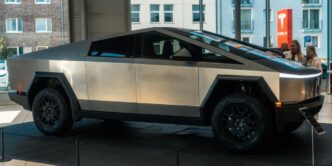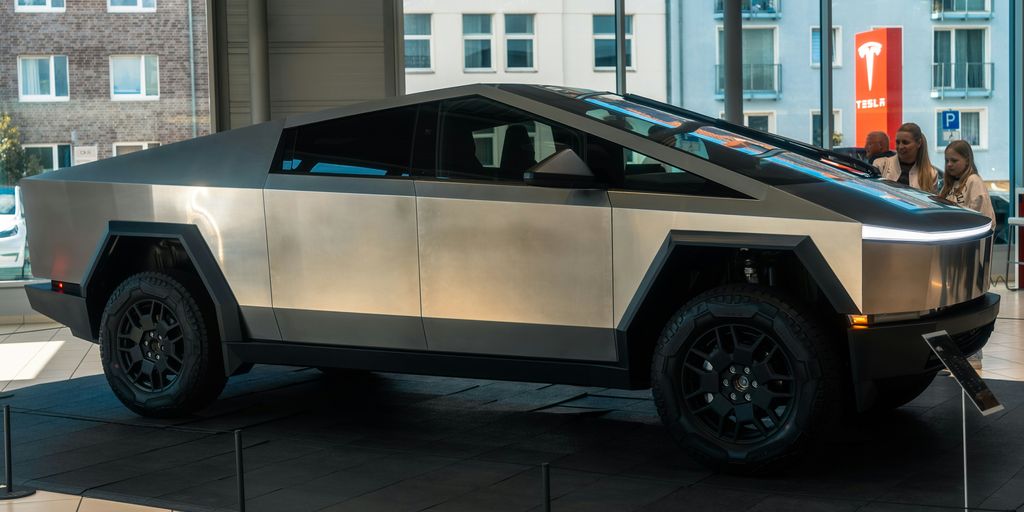The Tesla Cybertruck has always been a big talking point, and a common question people have is about its actual weight. It looks really tough and unique, so it makes sense that folks are curious how much it weighs. In this article, we’re going to take a close look at the cybertruck weight, checking out what Tesla says and how its special design affects its overall mass.
Key Takeaways
- The official cybertruck weight figures change based on the specific model, like the Cyberbeast or the dual-motor version.
- The unique stainless steel body and the large battery pack are big factors in the Cybertruck’s total mass.
- The Cybertruck’s weight has an effect on how far it can travel on a charge and how fast it can accelerate.
- Its heavy build is also connected to its impressive payload and towing limits, showing it’s a strong truck.
- When you put the cybertruck weight next to other electric trucks, it often comes out as one of the heavier options.
Understanding the Cybertruck’s Official Weight Figures
Alright, let’s get down to brass tacks and talk about the Cybertruck’s weight. It’s been a hot topic since the thing was first announced, and honestly, the numbers have been a bit all over the place. But now that we’re seeing actual Cybertrucks rolling out, we can start to nail down some concrete figures. We’ll break down the different models and what affects their overall mass.
Decoding the Cyberbeast’s Curb Weight
The Cyberbeast, being the top-of-the-line model, is naturally the heaviest of the bunch. The official curb weight for the Cyberbeast comes in at around 6,901 pounds (3,130 kg). That’s a hefty number, no doubt, and it’s largely due to the tri-motor setup and the larger battery pack needed to power those motors. It’s important to remember that curb weight refers to the weight of the vehicle with all standard equipment, fluids, and a full tank of fuel (or in this case, a fully charged battery), but without any passengers or cargo. This battery-electric beast is ready to roll!
Weight Specifications for Dual-Motor and RWD Variants
Okay, so the Cyberbeast is the heavyweight champ, but what about the other Cybertruck models? The dual-motor AWD variant is lighter, but still packs a punch. While exact figures can vary slightly, expect it to be somewhere in the neighborhood of 6,670 pounds. The single-motor RWD version should be the lightest of the three, but Tesla hasn’t released official numbers for that one yet. As we get more info, we’ll update this, but it’s safe to assume it’ll be a few hundred pounds lighter than the dual-motor. The Ford F-150 Lightning is a close competitor.
The Impact of Battery Pack Size on Overall Mass
Let’s be real, the battery pack is a HUGE contributor to the Cybertruck’s weight. Electric vehicle batteries are heavy, plain and simple. The bigger the battery, the more range you get, but the more weight you add. It’s a trade-off. The Cyberbeast, with its larger battery pack for maximum range and power output, is going to be significantly heavier than a RWD version with a smaller battery. This is just the nature of the beast (pun intended!). The Cybertruck Owners Club is a great resource for more information. The Cybertruck’s towing capacity is impressive.
Design and Materials Influencing Cybertruck Weight

The Ultra-Hard Stainless Steel Exoskeleton’s Contribution
Okay, so the Cybertruck is different from other trucks, right? Instead of the usual body-on-frame thing, it’s got this "exoskeleton." Basically, the outside of the truck is also the structure. This design is supposed to make it lighter than if it were made the old way, even though it’s stainless steel. Tesla uses a special kind of stainless steel, Ultra-Hard 30X Cold-Rolled, and it’s supposed to be super strong. Road debris and door dings? Supposedly, they’re not a problem anymore. The Cybertruck exoskeleton is a big deal because it changes how the truck is put together. The 300-series stainless-steel panels have a thickness of 0.071 and 0.055 in (1.8 and 1.4 mm) for the doors and body, respectively, according to a factory tour video.
Adaptive Air Suspension and Its Weight Implications
The Cybertruck has adaptive air suspension, which is pretty cool. It can adjust the ride height depending on whether you’re on the road or off. But all that fancy tech adds weight. The air suspension system includes:
- Air compressors
- Air lines
- Suspension components
- Control units
All these parts contribute to the overall mass of the vehicle. It’s a trade-off: you get better performance and flexibility, but you also add weight. The Cybertruck will sport an adaptive air suspension system with both on-road and off-road modes.
How 4680 Battery Technology Affects Vehicle Mass
The 4680 battery cells are Tesla’s new thing, and they’re supposed to be better than the old batteries. They’re bigger, so they can store more energy. But bigger also means heavier. The battery pack is one of the heaviest parts of any electric vehicle, and the Cybertruck is no exception. The battery size has a big impact on the truck’s total weight. The Cybertruck’s payload and towing capacities make it a force to be reckoned with.
Cybertruck Dimensions and Their Relation to Weight
Analyzing Length, Width, and Height for Mass Distribution
Okay, so the Cybertruck is big. We all know that. But how do those dimensions actually affect the weight and, more importantly, how it handles? The Cybertruck’s dimensions play a huge role in its overall mass distribution. A longer wheelbase, for example, can improve stability but also adds weight. The height impacts the center of gravity, which is super important for handling, especially in a vehicle this heavy. It’s a balancing act, really. Tesla had to consider all these factors to make sure it doesn’t feel like you’re driving a building.
Bed Size and Cargo Volume’s Effect on Practical Weight
The Cybertruck’s bed is a big deal. Not just because it looks cool, but because it can hold a TON of stuff. The bed size directly impacts how much weight you can practically carry. A bigger bed means more potential cargo, which translates to more weight. The Cybertruck bed size is above standard at 6.5 feet, allowing for 100 cu ft of space. That’s a lot more than some competitors. Think about it: hauling a load of gravel is way different than hauling a few bags of groceries. The bed’s volume and the materials used in its construction all contribute to the overall weight, both empty and when loaded up.
Interior Capacity and Passenger Load Considerations
It’s not just about the bed; the interior matters too! The Cybertruck is supposed to seat six people. That’s six adults, potentially, plus whatever gear they bring along. All that adds up! Passenger weight is a significant factor in overall vehicle weight, and it affects everything from acceleration to braking. Tesla had to design the suspension and powertrain to handle a fully loaded cabin without sacrificing performance or safety. The interior design, materials, and seating arrangement all contribute to the final weight figure. It’s all connected, you know?
Payload and Towing Capabilities Tied to Cybertruck Weight
Maximizing the Cybertruck’s Payload Capacity
Okay, so you’re thinking about loading up the Cybertruck. Cool. The payload capacity is something to keep in mind, because exceeding it can mess with handling and braking. It’s not just about how much stuff fits in the bed; it’s about the weight of that stuff. Think construction materials, camping gear, or even just a bunch of heavy suitcases. Distribute the weight evenly, and don’t forget to factor in the weight of any passengers or accessories you’ve added. The Cybertruck bed size is pretty generous, but that just means you can potentially overload it more easily if you aren’t careful.
Towing Limits Across Different Cybertruck Trims
The Cybertruck’s towing capacity varies depending on the trim you choose. The tri-motor Cyberbeast’s curb weight can tow the most, while the single-motor version tows the least. Here’s a quick breakdown:
- Single-Motor: Around 7,500 lbs
- Dual-Motor: Roughly 11,000 lbs
- Tri-Motor: Up to 14,000 lbs
These are maximum figures, of course. Real-world towing performance will depend on factors like road conditions, trailer type, and how well you distribute the load. Don’t just assume you can hook up any trailer and go; check the trailer’s weight and make sure you’re within the Cybertruck’s limits. Also, remember that towing impacts range, so plan your trips accordingly.
Comparing Hauling Prowess with Competitors
So, how does the Cybertruck stack up against other electric trucks when it comes to hauling? Well, it’s a pretty strong contender. The Ford F-150 Lightning, Chevy Silverado EV, and Rivian R1T all offer respectable towing capabilities, but the Cybertruck’s numbers are definitely competitive. It’s important to look at both payload and towing when making a comparison. Some trucks might have a higher payload capacity but lower towing, or vice versa. Ultimately, the best truck for you will depend on your specific needs. Are you planning on hauling heavy equipment regularly, or just need something for occasional weekend trips? Consider what you’ll actually be using the truck for before making a decision.
Cybertruck Weight in the Electric Truck Landscape
Benchmarking Against the Ford F-150 Lightning
Okay, so the Cybertruck is here, and everyone wants to know how it stacks up against the old guard, specifically the Ford F-150 Lightning. The Lightning was one of the first big players in the electric truck game, and it set a pretty high bar. The Cybertruck aims to either match or exceed the Lightning in key areas like towing and payload. But weight? That’s where things get interesting. The Lightning is already a hefty vehicle, and the Cybertruck, with its stainless steel exoskeleton, is expected to be even heavier. This difference in weight could affect range and efficiency, so it’s something to keep an eye on. We need to see real-world tests to know for sure, but on paper, the F-150 Lightning is a strong contender.
How It Compares to Chevy Silverado EV and Ram 1500 REV
Now, let’s throw the Chevy Silverado EV and Ram 1500 REV into the mix. These are two more electric trucks vying for the same market share as the Cybertruck. The Silverado EV, like the Lightning, is built on a more traditional truck platform, while the Ram 1500 REV is trying to blend luxury with capability. Where does the Cybertruck fit? Well, its unique design and focus on durability set it apart. But when it comes to weight, it’s a balancing act. A heavier truck can mean better towing capacity and a more stable ride, but it can also hurt acceleration and range. Here’s a quick comparison:
- Cybertruck: Known for its stainless steel body and angular design.
- Silverado EV: A more conventional electric truck with a focus on work capabilities.
- Ram 1500 REV: Blends luxury features with truck functionality.
Rivian R1T and the Competitive Weight Spectrum
Finally, we can’t forget about the Rivian R1T. The R1T was one of the first electric trucks to hit the market, and it carved out a niche for itself with its focus on adventure and off-road capability. The R1T is lighter than the Cybertruck, which gives it an advantage in terms of agility and efficiency. However, the Cybertruck boasts a higher payload and towing capacity. It really comes down to what you prioritize in an electric truck. Are you looking for a nimble off-roader, or a heavy-duty workhorse? The Cybertruck’s weight plays a big role in defining its place in the electric truck landscape. The R1T is a great all-arounder, but the Cybertruck is aiming for something different. It’s designed to be tough, durable, and capable, even if that means sacrificing some efficiency. The Rivian is a solid choice, but the Cybertruck is in a class of its own.
The Quest for Accurate Cybertruck Weight Data
It’s been a wild ride trying to nail down the true weight of the Cybertruck. Tesla hasn’t exactly been forthcoming with all the details, so we’ve had to piece things together from various sources. It’s like a giant puzzle, and we’re still missing a few pieces. Let’s look at what we’ve found so far.
Insights from Official Tesla Store Displays
One of the best sources of information has been from people visiting Tesla stores and snapping photos of the Cybertruck’s spec sheet. These displays often reveal key numbers that aren’t readily available online. For example, a Cybertruck Owners Club member posted information from a display in San Diego, which gave us some concrete figures to work with. It’s still important to remember that these are subject to change, but it’s better than nothing! It’s great to see the Cybertruck display in person.
Unpacking Clues from NHTSA Documents
We’ve also been digging through documents from the National Highway Traffic Safety Administration (NHTSA). These filings sometimes contain hints about the Cybertruck’s weight, even if they don’t explicitly state it. It’s like reading between the lines, but it can be a useful way to corroborate information from other sources. Our previous investigations provided some breadcrumbs in the form of a NHTSA document, but let’s face it, educated guesses only take us so far in the world of electric trucks.
Community Discoveries and Verified Specifications
The Cybertruck community has been incredibly helpful in this quest. People are sharing information, comparing notes, and trying to verify specs through their own tests. It’s a collaborative effort, and it’s been amazing to see. Here’s what we know:
- The Cyberbeast is listed around 6,901 lbs.
- Payload capacity is around 2,500 pounds.
- Towing capacity is around 11,000 pounds.
Of course, we’re still waiting for Tesla to release the official, definitive numbers. But until then, we’ll keep digging and sharing what we find. The global tire market is also something to keep an eye on, as tire choice can impact the overall weight and performance of the Cybertruck.
Performance and Efficiency: The Role of Cybertruck Weight
Acceleration Times Versus Vehicle Mass
Okay, so the Cybertruck is built like a tank, right? That stainless steel isn’t exactly lightweight. But how does all that mass affect how fast it can go? Well, it’s a balancing act. More weight usually means slower acceleration, but Tesla’s electric motors pack a serious punch. The Cyberbeast trim, with its insane horsepower, aims to offset the weight disadvantage with sheer power. We’re still waiting on official, independent tests, but early indications suggest it can still move pretty quickly, even with all that heft. It’s all about that power-to-weight ratio, and Tesla seems to be pushing the limits.
Range Estimates and the Weight of the Battery
Here’s where things get interesting. The battery pack is a huge contributor to the Cybertruck’s overall weight. And, of course, the bigger the battery, the more range you get. But a bigger battery also means more weight, which can then reduce efficiency. It’s a trade-off. Tesla is trying to maximize range while keeping the weight manageable. The 4680 battery technology is supposed to help with this, offering higher energy density in a smaller package. But at the end of the day, physics is physics. A heavier truck will generally use more energy to travel the same distance as a lighter one. We’ll need to see real-world range tests to get a clear picture of how the Cybertruck performs.
Handling Characteristics of a Heavy Electric Truck
Let’s be real, the Cybertruck isn’t a sports car. It’s a big, heavy truck. That means it’s not going to handle like a nimble sedan. The weight distribution and suspension design play a huge role here. Tesla’s adaptive air suspension is supposed to help improve handling, but there’s no getting around the fact that you’re dealing with a lot of mass. Expect a different driving experience compared to lighter electric vehicles. Things like cornering and braking distances will be affected. It’ll be interesting to see how the Cybertruck handles in different conditions, especially off-road. The Cybertruck Owners Club will surely have some opinions on this soon enough. The electric trucks market is getting more interesting every day.
Conclusion
Alright, so we’ve gone through all the details, and it’s pretty clear the Cybertruck isn’t exactly a lightweight. That huge battery pack and the super strong stainless steel body definitely pack on the pounds. But hey, all that weight isn’t just sitting there; it helps the truck handle some serious jobs. We’re talking about pulling big trailers and hauling a bunch of stuff in the back. Knowing what this thing weighs really helps you get a picture of what it’s all about and how it stacks up against other trucks out there. It’s a unique ride, that’s for sure, and its weight is a big part of its story.
Frequently Asked Questions
What are the official weights for the different Cybertruck models?
The official weight for the top-tier Cyberbeast model is around 6,901 pounds (about 3,130 kilograms). While specific numbers for the dual-motor and rear-wheel drive versions were not immediately available, the Cyberbeast is the heaviest due to its powerful setup.
Why does the Cybertruck weigh so much?
The Cybertruck is quite heavy mainly because of its unique “ultra-hard stainless-steel” body, which is very strong and dense. Also, its large battery pack, especially the advanced 4680 battery cells, adds a lot to its overall mass.
How does the Cybertruck’s size relate to its weight?
The Cybertruck’s large size, measuring 231.7 inches long, 79.8 inches wide, and 75 inches tall, means it uses a lot of material, especially the heavy steel. This big build directly adds to its weight. Its deep truck bed can also hold a lot of cargo, which increases its practical weight when loaded.
What are the Cybertruck’s capacities for carrying and towing?
The Cybertruck is designed for heavy work. It can carry up to 2,500 pounds in its bed, which is called its payload capacity. For towing, it can pull up to 11,000 pounds. These numbers show it’s built to handle substantial loads.
How does the Cybertruck’s weight compare to other electric pickup trucks?
The Cybertruck is one of the heavier electric trucks on the market. Its weight, especially the Cyberbeast model, tends to be higher than competitors like the Ford F-150 Lightning or Rivian R1T, largely due to its strong steel body and big battery.
Where can I find reliable information about the Cybertruck’s weight?
Accurate weight details for the Cybertruck have come from several reliable places. This includes information displayed at official Tesla stores and documents from the National Highway Traffic Safety Administration (NHTSA). The Cybertruck Owners Club has also shared verified specifications from these sources.












